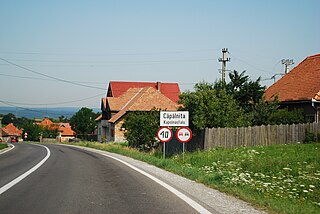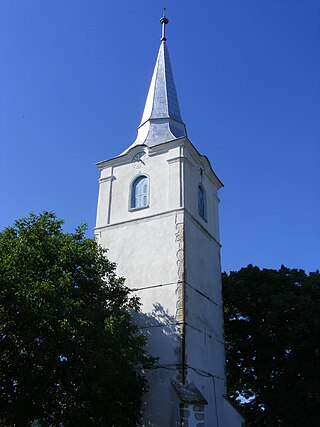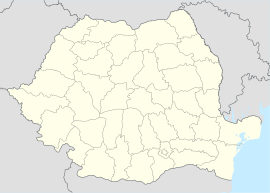
Cristuru Secuiesc is a town in Harghita County, Romania. It lies in the Székely Land, an ethno-cultural region in eastern Transylvania. The town administers two villages: Betești (Betfalva), part of Mugeni until 2004, and Filiaș (Fiatfalva).

Vlăhița is a town in Harghita County, Romania. It lies in the Székely Land, an ethno-cultural region in eastern Transylvania.

Atid is a commune in Harghita County, Romania. It lies in the Székely Land, an ethno-cultural region in eastern Transylvania. The route of the Via Transilvanica long-distance trail passes through the village of Inlăceni, which is administered by Atid commune.

Avrămești is a commune in Harghita County, Romania. It lies in the Székely Land, an ethno-cultural region in eastern Transylvania.

Brădești is a commune in Harghita County, Romania. It lies in the Székely Land, an ethno-cultural region in eastern Transylvania. The commune is composed of two villages: Brădești and Târnovița (Küküllőkeményfalva).

Căpâlnița is a commune in Harghita County, Romania. It lies in the Székely Land, an ethno-cultural region in eastern Transylvania. It is composed of a single village, Căpâlnița.

Corund is a commune in Harghita County, Romania. It lies in the Székely Land, an ethno-cultural region in eastern Transylvania, in the "Salt Region", and is formed of five villages: Atia (Atyha), Calonda (Kalonda), Corund (Korond), Fântâna Brazilor (Fenyőkút), and Valea lui Pavel (Pálpataka).

Dealu is a commune in Harghita County, Romania. It lies in the Székely Land, an ethno-cultural region in eastern Transylvania. The commune is composed of seven villages: Dealu, Fâncel (Székelyfancsal), Sâncrai (Székelyszentkirály), Tămașu (Székelyszenttamás), Tibod (Tibód), Ulcani (Ülke), and Valea Rotundă (Uknyéd).

Feliceni is a commune in Harghita County, Romania, in the vicinity of Odorheiu Secuiesc. It forms part of the Székely Land, an ethno-cultural region in eastern Transylvania.

Lupeni is a commune in Harghita County, Transylvania, Romania. It lies in the Székely Land, an ethno-cultural region in eastern Transylvania. The commune is composed of nine villages: Bisericani (Székelyszentlélek), Bulgăreni (Bogárfalva), Firtușu (Firtosváralja), Lupeni, Morăreni (Nyikómalomfalva), Păltiniș (Kecset), Păuleni (Székelypálfalva), Satu Mic (Kecsetkisfalud), and Sâncel (Szencsed).

Mărtiniș is a commune in Harghita County, Romania. It is composed of twelve villages: Aldea (Abásfalva), Bădeni (Bágy), Călugăreni (Homoródremete), Chinușu (Kénos), Comănești (Homoródkeményfalva), Ghipeș (Gyepes), Locodeni (Lókod), Mărtiniș, Orășeni (Városfalva), Petreni (Homoródszentpéter), Rareș (Recsenyéd), and Sânpaul (Homoródszentpál).

Merești is a commune in Harghita County, Romania. It lies in the Székely Land, an ethno-cultural region in eastern Transylvania. It is composed of a single village, Merești. Its elevation is 557 m (1,827 ft).

Mugeni is a commune in Harghita County, Romania. It lies in the Székely Land, an ethno-cultural region in eastern Transylvania.

Ocland is a commune in Harghita County, Romania. It lies in the Székely Land, an ethno-cultural region in eastern Transylvania. The commune is composed of three villages: Crăciunel (Karácsonyfalva), Ocland, and Satu Nou (Homoródújfalu).

Săcel is a commune in Harghita County, Romania. It lies in the Székely Land, an ethno-cultural region in eastern Transylvania.

Șimonești is a commune in Harghita County, Romania. It lies in the Székely Land, an ethno-cultural region in eastern Transylvania.

Ghelința is a commune in Covasna County, Transylvania, Romania. It is composed of two villages, Ghelința and Harale (Haraly).

Turia is a commune in Covasna County, Transylvania, Romania composed of two villages: Alungeni (Futásfalva) and Turia.

Vețca is a commune in Mureș County, Transylvania, Romania that is composed of three villages: Jacodu (Magyarzsákod), Sălașuri (Székelyszállás), and Vețca.

Laslea is a commune located in Sibiu County, Transylvania, Romania. It is composed of five villages: Florești, Laslea, Mălâncrav, Nou Săsesc, and Roandola. The route of the Via Transilvanica long-distance trail passes through the villages of Florești, Mălâncrav, and Nou Săsesc.































